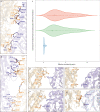Structural insights into the mechanism of GTP initiation of microtubule assembly
- PMID: 37749104
- PMCID: PMC10519996
- DOI: 10.1038/s41467-023-41615-w
Structural insights into the mechanism of GTP initiation of microtubule assembly
Abstract
In eukaryotes, the dynamic assembly of microtubules (MT) plays an important role in numerous cellular processes. The underlying mechanism of GTP triggering MT assembly is still unknown. Here, we present cryo-EM structures of tubulin heterodimer at their GTP- and GDP-bound states, intermediate assembly states of GTP-tubulin, and final assembly stages of MT. Both GTP- and GDP-tubulin heterodimers adopt similar curved conformations with subtle flexibility differences. In head-to-tail oligomers of tubulin heterodimers, the inter-dimer interface of GDP-tubulin exhibits greater flexibility, particularly in tangential bending. Cryo-EM of the intermediate assembly states reveals two types of tubulin lateral contacts, "Tube-bond" and "MT-bond". Further, molecular dynamics (MD) simulations show that GTP triggers lateral contact formation in MT assembly in multiple sequential steps, gradually straightening the curved tubulin heterodimers. Therefore, we propose a flexible model of GTP-initiated MT assembly, including the formation of longitudinal and lateral contacts, to explain the nucleation and assembly of MT.
© 2023. Springer Nature Limited.
Conflict of interest statement
The authors declare no competing interests.
Figures







Similar articles
-
Intrinsic bending and structural rearrangement of tubulin dimer: molecular dynamics simulations and coarse-grained analysis.Biophys J. 2008 Sep;95(5):2487-99. doi: 10.1529/biophysj.108.129072. Epub 2008 May 30. Biophys J. 2008. PMID: 18515385 Free PMC article.
-
Nucleotide-dependent bending flexibility of tubulin regulates microtubule assembly.Nature. 2005 Jun 16;435(7044):911-5. doi: 10.1038/nature03606. Nature. 2005. PMID: 15959508 Free PMC article.
-
Effect of tubulin self-association on GTP hydrolysis and nucleotide exchange reactions.Biochim Biophys Acta Proteins Proteom. 2023 Feb 1;1871(2):140869. doi: 10.1016/j.bbapap.2022.140869. Epub 2022 Nov 15. Biochim Biophys Acta Proteins Proteom. 2023. PMID: 36400388
-
The Mechanism of Tubulin Assembly into Microtubules: Insights from Structural Studies.iScience. 2020 Aug 29;23(9):101511. doi: 10.1016/j.isci.2020.101511. eCollection 2020 Sep 25. iScience. 2020. PMID: 32920486 Free PMC article. Review.
-
How tubulin subunits are lost from the shortening ends of microtubules.J Struct Biol. 1997 Mar;118(2):107-18. doi: 10.1006/jsbi.1997.3844. J Struct Biol. 1997. PMID: 9126637 Review.
Cited by
-
Mechanisms of microtubule dynamics from single-molecule measurements.bioRxiv [Preprint]. 2025 Jun 27:2025.06.25.661545. doi: 10.1101/2025.06.25.661545. bioRxiv. 2025. PMID: 40667042 Free PMC article. Preprint.
-
Omics-Driven Strategies for Developing Saline-Smart Lentils: A Comprehensive Review.Int J Mol Sci. 2024 Oct 22;25(21):11360. doi: 10.3390/ijms252111360. Int J Mol Sci. 2024. PMID: 39518913 Free PMC article. Review.
-
β3 accelerates microtubule plus end maturation through a divergent lateral interface.Mol Biol Cell. 2025 Apr 1;36(4):ar36. doi: 10.1091/mbc.E24-08-0354. Epub 2025 Jan 15. Mol Biol Cell. 2025. PMID: 39813077 Free PMC article.
-
Cytoplasmic physicochemical factors drive malignant transformation by adapting bioenergetic settings.Biochem Biophys Rep. 2025 Jun 7;43:102079. doi: 10.1016/j.bbrep.2025.102079. eCollection 2025 Sep. Biochem Biophys Rep. 2025. PMID: 40535783 Free PMC article.
-
Structural switching of tubulin in the microtubule lattice.Biochem Soc Trans. 2025 Feb 5;53(1):BST20240360. doi: 10.1042/BST20240360. Biochem Soc Trans. 2025. PMID: 39910801 Free PMC article. Review.
References
-
- Roostalu J, Surrey T. Microtubule nucleation: beyond the template. Nat. Rev. Mol. Cell Biol. 2017;18:702–710. - PubMed
-
- Kaul R, Risinger AL, Mooberry SL. Microtubule-targeting drugs: more than antimitotics. J. Nat. Prod. 2019;82:680–685. - PubMed
-
- Dostál V, Libusová L. Microtubule drugs: action, selectivity, and resistance across the kingdoms of life. Protoplasma. 2014;251:991–1005. - PubMed
-
- Gudimchuk NB, McIntosh JR. Regulation of microtubule dynamics, mechanics and function through the growing tip. Nat. Rev. Mol. Cell Biol. 2021;22:777–795. - PubMed
-
- Jordan MA, Kamath K. How do microtubule-targeted drugs work? An overview. Curr. Cancer Drug Targets. 2007;7:730–742. - PubMed
Publication types
MeSH terms
Substances
LinkOut - more resources
Full Text Sources

